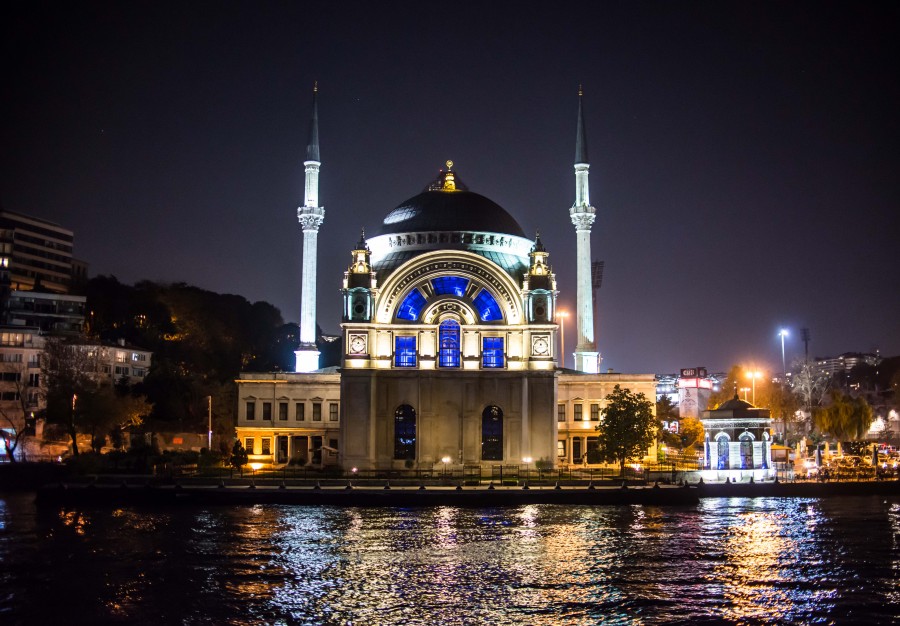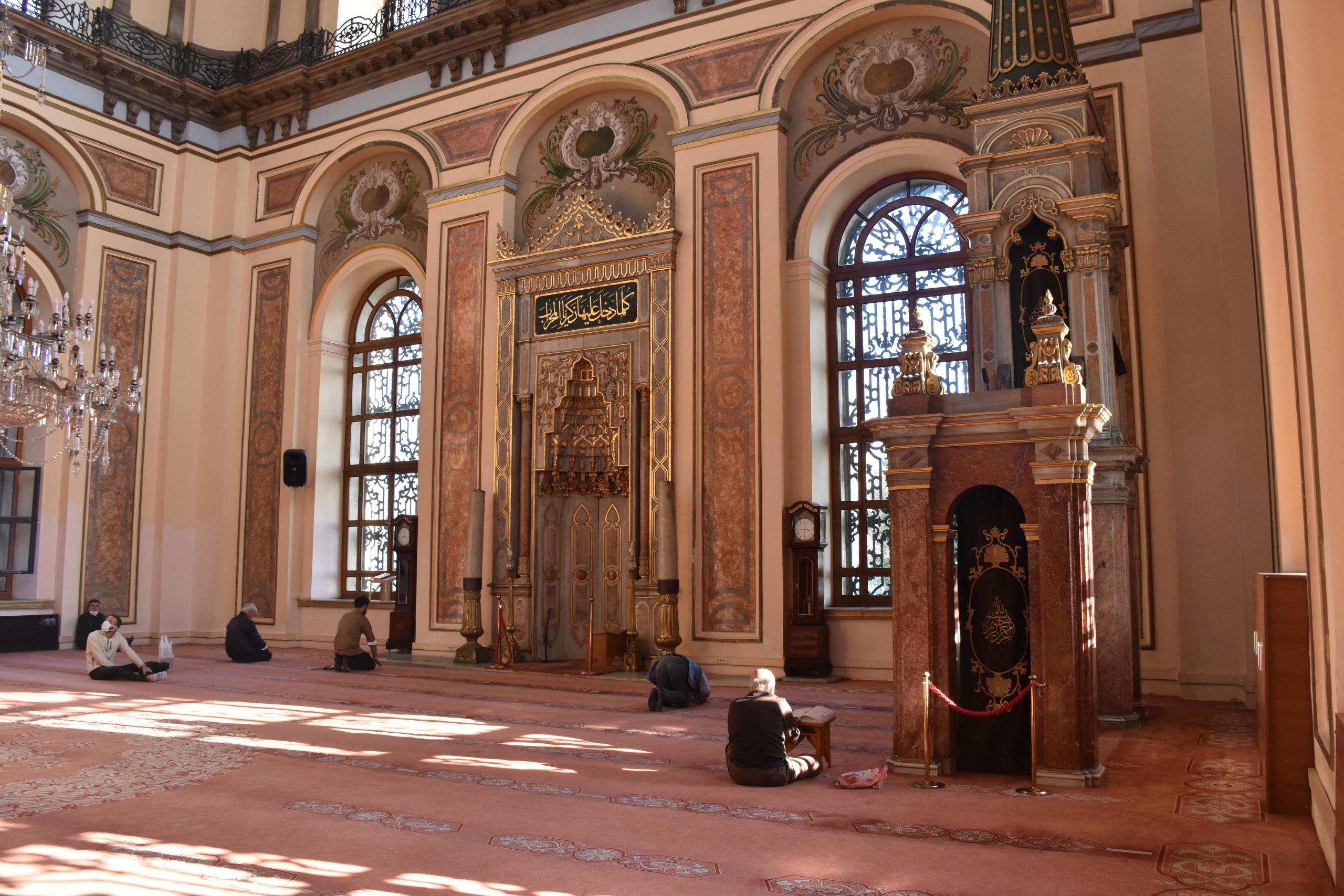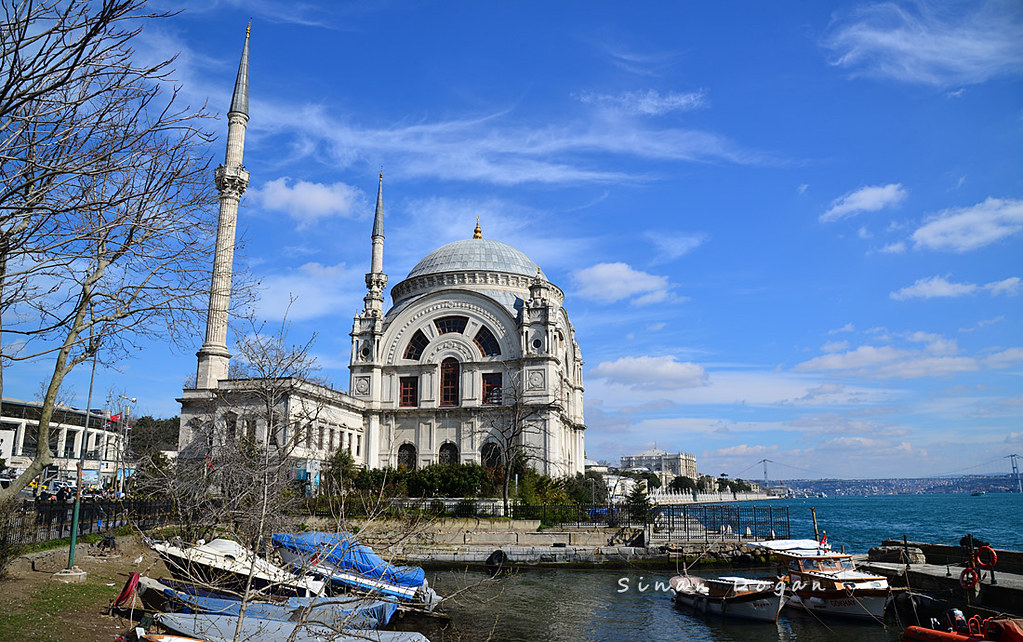Dolmabahce Mosque, or as known as Bezmialem Valide Sultan Mosque, was built on the shore of Beyoğlu, Istanbul. As an architectural figure on the edge of the Bosphorus, Dolmabahce Mosque makes a contribution to where it locates. On a Bosphorus tour, Dolmabahce Mosque will clarify itself with all its glory.
History of Dolmabahce Mosque

Bezmialem Valide Sultan was acquainted with her charities, and she decided to build a mosque for the local people. The mosque was planned to build by the queen mother of Sultan Abdülmecid, however, during its construction, the queen passed away. Therefore, his son Sultan Abdülmecid had the mosque continue after his mother’s funeral. Dolmabahce Mosque’s foundation date is 1855.
The mosque was arranged to be named Bezmialem Valide Sultan, due to the Sultan’s mother’s name, however, because it is located in the field of Dolmabahce Palace, it is known as Dolmabahce Mosque by the community. Just like Taksim Mosque, Dolamabahce Mosque was opened in a Friday Prayer, with the accompany of Sultan Aldülmecid. Dolmabahce Mosque is considered “Selatin Mosque”, which means the mosque was built by the members of the royal family.
History of Architecture of Dolmabahce Mosque

Has a mark on most of the imperial buildings in Istanbul and the same architect of Dolmabahce Palace, Garabet Balyan was the Armenian architect who built Dolmabahce mosque. Dolmabahce Palace and Dolmabahce Mosque were built by the same architect, however, in terms of appearance, they are not related.
Dolmabahce Mosque is distinguished by its twin minarets and massive stone arches. Unlike traditional Ottoman imperial mosques, the windows of the mosque are pretty huge, which enables them to take the sunlight in. Both have modern and traditional features, Dolmabahce Mosque is a mixture of East and West. The mosque was built in Baroque Architecture and ampere style. Square-planned and long Dolmabahce Mosque has a part for sultans. The outer part of the mosque has modern look, with the colours grey and white. The influence of Baroque and ampere styles is seen inside the mosque. Traditional Ottoman adornments were supplanted by Baroque and ampere styles. In that sense, Dolmabahce Mosque is presenting the era to which it belonged. The inside of the mosque was divided into three parts, the first part is the place where people pray. On the bottom part, there are fancy plasters, all of them are furnished. These plasters also have a mission as a column. Other parts have a design just like the first part, yet they are not long in height. Unlike other traditional mosques, Dolmabahce Mosque has no semi-domes, just has a main dome, supported by 4 arches. In the middle of the 4 columns and the dome, pendentives were used, which is an unusual practice in traditional Ottoman Architecture. In the early Ottoman Empire, pendentives had a traditional design, yet in the late Ottoman, these designs shifted their shapes. Dolmabahce Mosque is an example of changing architectural patterns. Square-planned Mosque and a dome which is supported by four columns are a kind of baldachins or named ciborium in churches. Baldachins are also another architectural features that are used in the mosque. Nomad old Turks used baldachins in their tents. The mosque has a gigantic chandelier that enlightens the inside.
Most imperial mosques have a special room for sultans. That mosque’s room for sultans is a duplex. Even if local people could not interact with the sultan, they knew that the sultan is praying with them simultaneously.
The mosque has a little building which is specified the prayer times. These buildings are called “muvakkithane” and the attendant who is on duty with clarifying the prayer times is called “muvakkit”.
The mosque was used as a naval museum from 1956 to 1960. In the era of the May 27 Military Coup, the mosque was transformed into a mosque again.
Visiting hours depend on the prayer times. During these times, the mosque will be closed. Also, pay attention to the mosque etiquette while visiting. The entrance is not paid, yet donations are welcomed.
How to get to Dolmabahce Mosque?
Among all the transportation ways in Istanbul, the easier and more joyful one is the ferry, for sure. To be able to get to Dolmabahce Mosque, you can take Uskudar-Besiktas Ferry. Marmaray and Metro lines which are M4 and M5 other options. Lastly, Bus lines which are 11ÜS, 11Y, 12, 139A, 16A, and 320A also arrives there.
Which touristic places are near to Dolmabahce Mosque?
Apparently, Dolmabahce Mosque is located in the yard of Dolmabahce Palace, which is comfortable sightseeing. Dolmabahce Palace is one of the modern palaces in Istanbul, Turkey. Also, in the yard, there is a Painting Museum. The museum consists of an art collection which is painted in the 19th and 20th centuries. Or, if you want to rest in a green place, Maçka Democracy Park is not far away from Dolmabahce Mosque. Also, Taksim Square which is the center of Beyoğlu is 2.7 km far from Dolmabahce Mosque.
Where is Domabahce Mosque?
Dolmabahce Mosque is located in the courtyard of Dolmabahce Palace, and in Beyoğlu, Istanbul, Turkey.
How can I go to Dolmabahce Mosque?
Uskudar-Besiktas Ferry, Marmaray, Metro lines M4 and M5, and bus lines, 11ÜS, 11Y, 12, 139A, 16A, and 320A are the transportation ways to go to Dolmabahce Mosque.
What are the touristic places near to Dolmabahce Mosque?
Dolmabahce Palace, Painting Museum, Maçka Democracy Park, and Taksim Square are the nearest touristic places to Dolmabahce Mosque.
How can I go from Blue Mosque to Dolmabahce Mosque?
With the T1 tram line, you can easily go to Dolmabahce Mosque.
Boats rentals are waiting for you at Teknevia for those who want to enjoy the sea more in Istanbul.
